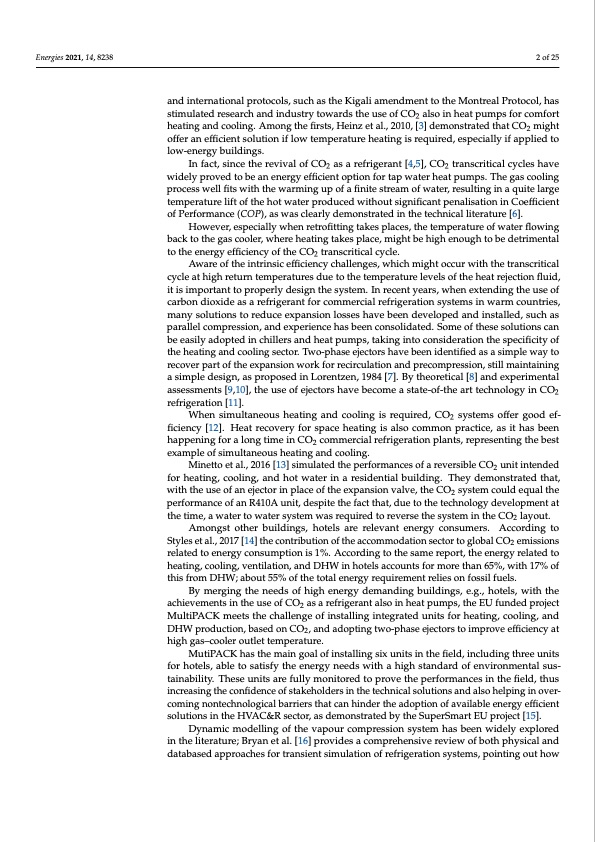
PDF Publication Title:
Text from PDF Page: 002
Energies 2021, 14, 8238 2 of 25 and international protocols, such as the Kigali amendment to the Montreal Protocol, has stimulated research and industry towards the use of CO2 also in heat pumps for comfort heating and cooling. Among the firsts, Heinz et al., 2010, [3] demonstrated that CO2 might offer an efficient solution if low temperature heating is required, especially if applied to low-energy buildings. In fact, since the revival of CO2 as a refrigerant [4,5], CO2 transcritical cycles have widely proved to be an energy efficient option for tap water heat pumps. The gas cooling process well fits with the warming up of a finite stream of water, resulting in a quite large temperature lift of the hot water produced without significant penalisation in Coefficient of Performance (COP), as was clearly demonstrated in the technical literature [6]. However, especially when retrofitting takes places, the temperature of water flowing back to the gas cooler, where heating takes place, might be high enough to be detrimental to the energy efficiency of the CO2 transcritical cycle. Aware of the intrinsic efficiency challenges, which might occur with the transcritical cycle at high return temperatures due to the temperature levels of the heat rejection fluid, it is important to properly design the system. In recent years, when extending the use of carbon dioxide as a refrigerant for commercial refrigeration systems in warm countries, many solutions to reduce expansion losses have been developed and installed, such as parallel compression, and experience has been consolidated. Some of these solutions can be easily adopted in chillers and heat pumps, taking into consideration the specificity of the heating and cooling sector. Two-phase ejectors have been identified as a simple way to recover part of the expansion work for recirculation and precompression, still maintaining a simple design, as proposed in Lorentzen, 1984 [7]. By theoretical [8] and experimental assessments [9,10], the use of ejectors have become a state-of-the art technology in CO2 refrigeration [11]. When simultaneous heating and cooling is required, CO2 systems offer good ef- ficiency [12]. Heat recovery for space heating is also common practice, as it has been happening for a long time in CO2 commercial refrigeration plants, representing the best example of simultaneous heating and cooling. Minetto et al., 2016 [13] simulated the performances of a reversible CO2 unit intended for heating, cooling, and hot water in a residential building. They demonstrated that, with the use of an ejector in place of the expansion valve, the CO2 system could equal the performance of an R410A unit, despite the fact that, due to the technology development at the time, a water to water system was required to reverse the system in the CO2 layout. Amongst other buildings, hotels are relevant energy consumers. According to Styles et al., 2017 [14] the contribution of the accommodation sector to global CO2 emissions related to energy consumption is 1%. According to the same report, the energy related to heating, cooling, ventilation, and DHW in hotels accounts for more than 65%, with 17% of this from DHW; about 55% of the total energy requirement relies on fossil fuels. By merging the needs of high energy demanding buildings, e.g., hotels, with the achievements in the use of CO2 as a refrigerant also in heat pumps, the EU funded project MultiPACK meets the challenge of installing integrated units for heating, cooling, and DHW production, based on CO2, and adopting two-phase ejectors to improve efficiency at high gas–cooler outlet temperature. MutiPACK has the main goal of installing six units in the field, including three units for hotels, able to satisfy the energy needs with a high standard of environmental sus- tainability. These units are fully monitored to prove the performances in the field, thus increasing the confidence of stakeholders in the technical solutions and also helping in over- coming nontechnological barriers that can hinder the adoption of available energy efficient solutions in the HVAC&R sector, as demonstrated by the SuperSmart EU project [15]. Dynamic modelling of the vapour compression system has been widely explored in the literature; Bryan et al. [16] provides a comprehensive review of both physical and databased approaches for transient simulation of refrigeration systems, pointing out howPDF Image | Dynamic Modelling and Validation of an Air-to-Water Reversible R744

PDF Search Title:
Dynamic Modelling and Validation of an Air-to-Water Reversible R744Original File Name Searched:
Artuso2021dma_publisert.pdfDIY PDF Search: Google It | Yahoo | Bing
CO2 Organic Rankine Cycle Experimenter Platform The supercritical CO2 phase change system is both a heat pump and organic rankine cycle which can be used for those purposes and as a supercritical extractor for advanced subcritical and supercritical extraction technology. Uses include producing nanoparticles, precious metal CO2 extraction, lithium battery recycling, and other applications... More Info
Heat Pumps CO2 ORC Heat Pump System Platform More Info
| CONTACT TEL: 608-238-6001 Email: greg@infinityturbine.com | RSS | AMP |